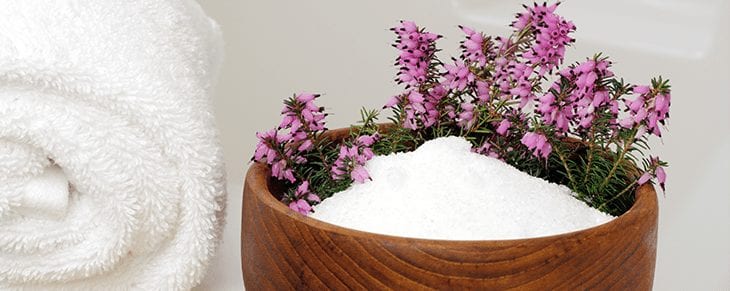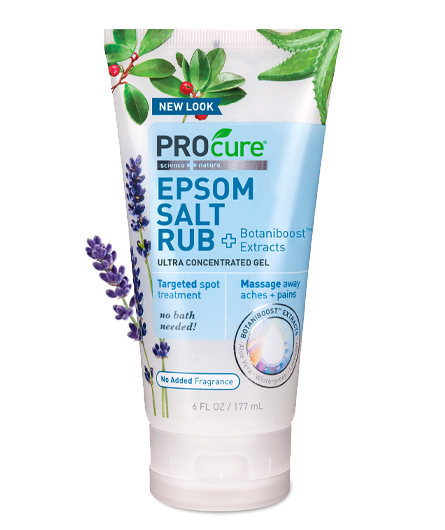How to Use Epsom Salt for Pain Relief

Epsom Salt Rub
Introducing Epsom Salt Rub, a concentrated spot treatment gel uniquely formulated with Aloe Vera and essential oils to soothe muscle tension, aches and pains.
Whether you’re suffering from overexertion or a demanding workout, PROcure’s new Epsom Salt Rub helps improve recovery by allowing you to apply the trusted remedy of Epsom Salt directly where it hurts most – without a bath. Rejuvenate and nourish those aches and pains away.

Epsom salt is a common recommendation for treating musculoskeletal pain. Everyone from your grandmother to your doctor promotes its use for relieving aches, cramps and various other sources of discomfort. If you’ve got time to relax in the tub, you can reap the benefits of a traditional Epsom salt soak, but don’t sweat it if you can’t make that happen. Epsom salt is also available as a topical pain reliever that is ideal for on-the-go use.
The Elements of Epsom Salt Pain Relief
Epsom salt baths offer a two-pronged source of relief for physical pain. You get the soothing, relaxing sensation of being surrounded by warm water along with the time-honored, pain-relieving power of magnesium sulfate, also known as Epsom salt. Even a short 15 minutes in an Epsom salt bath can make sprains, muscle cramps and other aches and pains melt away.
Soaking benefits aren’t just limited to your body. Dr. Valerie Ferdinand, ND, of Woodstock Natural Health Clinic in Portland, Oregon, points out the distinct psychological benefits associated with a comforting hot bath. The emotional soothing can also be helpful when you’re feeling distressed, annoyed, or even a bit morose as a result of physical discomfort. After all, pain isn’t just a physical issue. Take care to treat the emotional component as well as the physical.
A Soothing Epsom Salt Bath
So, how much Epsom salt do you need for an effective bath? Don’t be stingy! Pour in more than you think you need. “Usually people are only putting a cup of Epsom salt in their tub when really they could benefit from a much higher amount,” Dr. Ferdinand says.
You want to expose your skin to as much magnesium as possible in the water, so be generous with your Epsom salt-to-water ratio. If possible, add the salt to the tub before it’s full so it has plenty of time to dissolve in the warm water. If some solid salt crystals settle at the bottom of the tub, give the water a stir with your hand to help them dissolve.
It’s pleasant to mix essential oils with an Epsom salt bath, but it’s important to use caution when doing so. Citrus oils can actually burn the skin if you soak in them for too long or use them too much, and even soothing oils like lavender can be irritating to broken skin. Do a sensitivity test on a small patch of skin before soaking in any oils, and make sure you carefully follow all usage instructions. In general, safe oils to use include:
- Lavender to relax
- Spearmint and rosemary to provide an energy boost
- Orange, tangerine and grapefruit to improve mood
- Eucalyptus to open sinus passages and soothe aching muscles
- Peppermint to soothe sore muscles
- Ginger to reduce inflammation
Topical Epsom Salt Use
Taking a nice luxurious soak isn’t always an option. If you’re short on time or don’t have a suitable soaking tub, you can use a topical Epsom salt rub as a substitute for a bath. A rub gives you the benefits of the magnesium sulfate compound while you enjoy a little soothing massage at the site of your pain. As a bonus, magnesium sulfate has hydrating properties that leave your skin feeling silky and soft.
Epsom salt is a time-honored remedy for topical pain relief, and although baths are the most traditional method for enjoying the analgesic effects, they aren’t the only option. All-natural pain relief could literally be at your fingertips with the PROcure Epsom Salt Rub. As an alternative to a bath, it soothes body aches and cramps at the office or anywhere your day takes you.